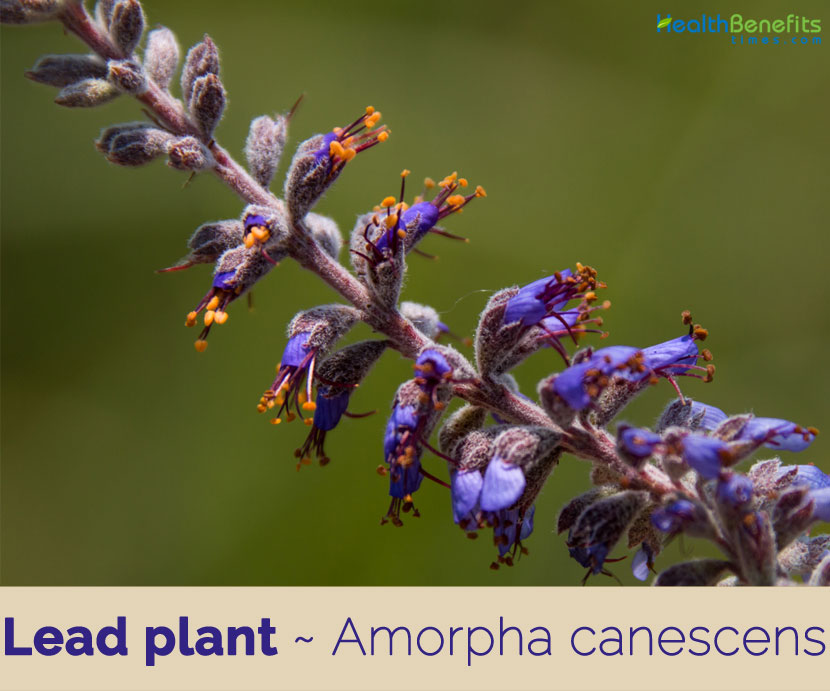| Lead plant Quick Facts | |
|---|---|
| Name: | Lead plant |
| Scientific Name: | Amorpha canescens |
| Origin | Areas in Manitoba and Ontario. In the U.S. it occurs from Montana east to Michigan, and south to New Mexico and Louisiana |
| Shapes | Modified legumes 3-4 mm long, 1.2-1.5 mm wide, slightly flattened, exserted beyond the persistent calyx tube |
| Health benefits | Beneficial for pinworms or any intestinal worms, stomach pains, eczema, neuralgia and rheumatism |
Plant Description
Lead plant is a sprawling, semi-erect, subshrub to herbaceous perennial plant that grows about 1 to 3.5 feet (0.3-1.1 m) tall. The plant is found growing in mesic to dry black soil prairies, sand prairies, gravel prairies, hill prairies, limestone glades, woodland and black oak savannas and remnant oak barrens. Leadplant is not particular about soil type, and it will flourish in loamy, sandy, gravelly, or clay soil. The plant has taproot and secondary lateral and vertical roots. Roots are branched and typically deeper than those of related bunchgrasses. It grows up to 5 m (16 ft.) deep and can spread up to 1 meter (3 ft. 3 in) radially. They may penetrate 7 to 20 feet (2-5 m), depending on the soil. Stem is ascending to erect, woody below, multiple from base, typically simple, canescent above, sparsely pubescent to glabrescent below, and striate-nerved. New stems are green and finely hairy which become woody with age.
Leaves
The leaves are compound, pinnately divided into 13 to 25 pairs of leaflets plus a terminal leaflet. Leaflets are generally oval to egg-shaped, rounded at both ends, about 1/2 inch long and half as wide. The leaf undersides and stems are covered with small whitish hairs, which as the leaf ages give the plant a grayish hue, hence the common name referring to ‘lead’. The prominent central leaflet vein extends beyond the rounded tip of the leaflet, forming a sharp point.
Inflorescence
The inflorescence consists of spike-like clusters (5 to 20) of small flowers at the ends of the stems. The weight of the spikes tends to cause the plant to tilt over, making it ‘semi-erect’.
The flowers are 5-parted, less than ¼ inch long with a 5-toothed purplish hairy calyx and a corolla which has a single petal that forms first a tube and then opens horizontally; initially shielded beneath it are the 8 stamens, pistil and style. This petal is the typical banner petal of a pea family flower. The laterals and keel petals are missing. The corolla varies from light purple to deep blue-violet. The bulging bright stamens are quite noticeable with reddish filaments and yellow-orange anthers. One plant typically has 5 or more spikes at the end of branching stems, the terminal spike being longer than the surrounding spikes. Flowers bloom from the bottom of the spike up. Flowering normally takes place from July to September.
Fruit and seed
Fertile flowers are followed by modified oblong, curved legumes 3-4 mm long, 1.2-1.5 mm wide, slightly flattened, exerted beyond the persistent calyx tube, hairy and gland-dotted, 1-seeded. Seed is a smooth brown bean 2.0-2.4 mm long, 1.0-1.4 mm wide, olive to reddish brown, oval with a slight hook at the tip. Seeds require a short period of cold stratification for germination.
Traditional uses and benefits of Lead plant
- An infusion of the leaves has been used to kill pinworms or any intestinal worms.
- The infusion is also used to treat eczema, the report does not say it if is used internally or externally.
- Dried and powdered leaves are applied as a salve to cuts and open wounds.
- Decoction of the root is used to treat stomach pains.
- A moxa of the twigs has been used in the treatment of neuralgia and rheumatism.
- Tea made from the leaves is used to treat ailments such as pinworms, eczema, rheumatism, neuralgia, open wounds, and cuts.
- Some indigenous tribes believed that the plant could aide in treating pinworms, eczema, rheumatism, neuralgia, open wounds, and cuts.
Other facts
- Plants have an extensive root system, they tolerate poor dry soils and are also wind resistant,
- They are used as a windbreak and also to prevent soil erosion.
- Resinous pustules on the plant contain ‘amorpha’, a contact and stomachic insecticide that also act as an insect repellent.
- Lead plant is an ideal ornamental species because it has showy flowers, is drought tolerant, and shade tolerant.
- Dried leaves were used for smoking.
References:
https://www.itis.gov/servlet/SingleRpt/SingleRpt?search_topic=TSN&search_value=25371#null
https://npgsweb.ars-grin.gov/gringlobal/taxonomydetail.aspx?id=2936
https://pfaf.org/user/Plant.aspx?LatinName=Amorpha+canescens
http://www.missouribotanicalgarden.org/PlantFinder/PlantFinderDetails.aspx?taxonid=242792
https://plants.usda.gov/core/profile?symbol=AMCA6
https://plants.usda.gov/factsheet/pdf/fs_amca6.pdf
https://www.fs.fed.us/database/feis/plants/shrub/amocan/all.html
https://en.wikipedia.org/wiki/Amorpha_canescens
https://m.wikidaily.org/wiki/Amorpha_canescens
http://www.theplantlist.org/tpl1.1/record/ild-24889
https://mnfi.anr.msu.edu/abstracts/botany/Amorpha_canescens.pdf
https://gd.eppo.int/taxon/AMHCN
https://wikivisually.com/wiki/Amorpha_canescens
https://www.illinoiswildflowers.info/prairie/plantx/leadplantx.htm
https://www.minnesotawildflowers.info/shrub/lead-plant
Comments
comments
